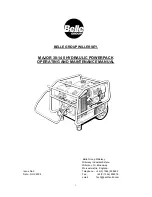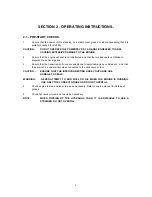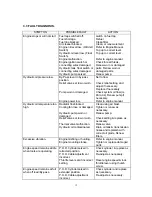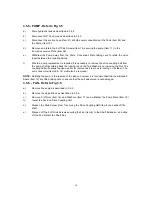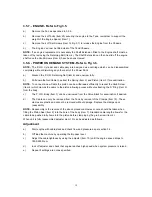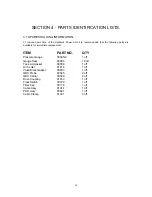
6
1.2 DESCRIPTION OF OPERATION.
The Petrol Engine (1) drives the hydraulic pump (2) via a drive coupling assembly. The hydraulic
pump draws oil from the tank (3) via a suction strainer and delivers it to the Valve Block (4) which
incorporates a By-Pass valve to allow oil to circulate round the system when first started. Flow is
directed to the Tool or Equipment via Non-Drip Quick Release Couplings after setting the By-Pass
lever to the flow position.
When the accessory tool or equipment is in operation, oil flows to the accessory and is directed back
through the return line at low pressure, through the Spin-on Return line filter (5) to tank, or via the
cooler (6) depending on the oil temperature which is monitored by the Thermal Valve,
Max pressure is controlled by a Relief Valve fitted into the Valve Block. If the supply pressure
exceeds that set by the relief valve, it operates to direct hydraulic oil back to the return line.
The oil pressure and hence the efficiency of the machine is influenced by temperature, and it is
important that the correct working temperature is maintained. The oil temperature is controlled by a
Thermal Valve, on initial start up the oil is cold and therefore its viscosity is high, The Thermal Valve
directs the oil to tank. until such time as the oil temperature rises to its minimum working level. The
Thermal Valve which incorporates a heat sensitive capsule will now direct the return line oil flow to
tank via the cooler, thereby stabilizing the oil temperature.
Cooling air for the radiator is provided by a fan which is mounted onto the engine shaft and enclosed
by a housing. The radiator is mounted at the side of the housing and is protected by a guard.
A filter condition gauge mounted on the cowl monitors the return line pressure. If the return line filter is
blocked the pressure will rise, and when the indicator needle reaches the red sector under normal
working conditions the filter should be replaced.
The supply line is protected from the ingress of dirt by a Suction Strainer situated in the hydraulic
tank. The Tank also incorporates a Sight Level Gauge and a Float Switch. The Level Gauge provides
indication of oil level,(The correct level being at the top of the sight glass) and the Float Switch
monitors the oil level and stops the engine at the preset low level.
The engine is fitted with an oil sensor, which operates in a similar manner to the hydraulic tank float
switch to protect the engine if its lubricating oil level falls below a safe level.
Summary of Contents for Major 30-140
Page 22: ...22 4 3 PARTS IDENTIFICATION LISTS Fig 3 1 FRAME CHASSIS ASSY ...
Page 24: ...24 Fig 3 2 Tank Assy ...
Page 26: ...26 Fig 3 3 Valve Block Assy ...
Page 28: ...28 Fig 3 4 Cooler Assy ...
Page 30: ...30 Fig 3 5 Pump Assy ...
Page 32: ...32 Fig 3 6 P O D Assy ...
Page 34: ...34 Fig 3 7 Hose Assy ...

